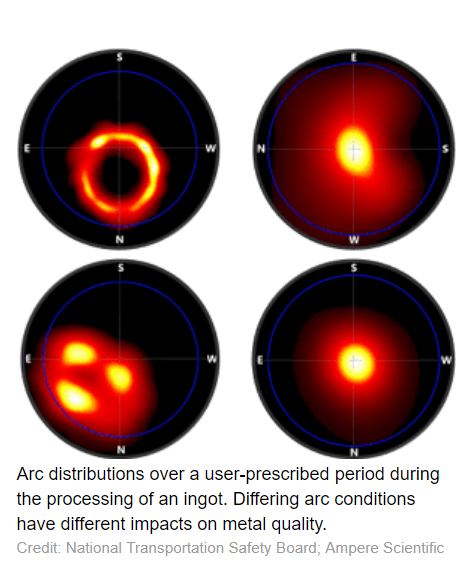New technology improves engine component safety

Commercial air travel is safer than it’s ever been. But mechanical failures can, and still do, occur. Flight UA 328, which left Denver, Colorado on Feb. 20, 2021, suffered a catastrophic engine failure four minutes into the flight. Fortunately, the airplane returned to the airport and landed safely. While the Federal Aviation Administration (FAA) is continually improving safety regulations, there’s more to be done to prevent critical engine failures.
Improvements can be made at the beginning of manufacturing during primary metal processing. Materials must be made to withstand the intense stresses and extreme temperatures components experience, such as turbine disks which hold the turbine blades together while spinning at >10,000rpm and at temperatures up to 1,700°C. Fan blades are also susceptible, as proven with flight UA 328. The National Transportation Safety Board (NTSB) determined the cause was fan blade out failure – two fan blades fractured from metal fatigue, often a result of macroscopic and microscopic discontinuities which can occur during primary metal processing.
Today’s manufacturing processes won’t produce the aircraft engine components of tomorrow. Meeting those standards requires a revolution in parts manufacturing where impeccable processes and precision equipment deliver supreme confidence in the material’s ability to achieve maximum performance.
Ampere Scientific and Consarc Corp. joined forces to apply sensors and software intelligence to revolutionize parts manufacturing. Their current mission is to detect conditions during the vacuum arc remelting (VAR) process that can lead to defects in critical engine components. They’ll use this technology to predict conditions that lead to defects and prevent them from occurring.
VAR furnaces remelt and refine specialty alloys which are formed into critical aeroengine parts in commercial and military aircraft. Current VAR furnaces rely on electrical signals for process control and ingot quality assessment rather than direct evaluation and real-time visualization of the growing ingot.
Ampere Scientific is determined to change that with its VARmetric arc positioning sensing technology that provides a view into the melting process. VARmetric combines advanced electromagnetic field sensing with Consarc’s VAR furnace measurements to capture, record, and display operating characteristics of the furnace not previously detectable during melting. It uses Consarc’s controls to monitor the furnace current, voltage, vacuum level, load cell, ram position/speed, and electromagnetic stirring. VARmetric then integrates measurements of the magnetic fields at a multitude of locations throughout the VAR to image the arc’s location interior to the VAR.
The result is real-time data showing:
Plots of furnace operational characteristics (current, voltage, vacuum, melt rate, ram speed, etc.)
Radial arc position overlaid on video images from VAR annulus cameras
Arc distribution through time
Arc distribution in axial cross-section
Electrode shape, position as a function of time
Alarms for side-arc conditions, extended arc gaps, other anomalous events or electrode movements
This data is available to the operator as the ingot is produced and can be used as part of the record of chain-of-custody for any qualified alloy ingot. This information can calculate the probability for solidification defects during operation as part of digital twinning. This gives metal producers, engine original equipment manufacturers (OEMs), and regulatory bodies more confidence that the materials they’re using are produced consistently and can withstand the rigors they are expected to face in extreme environments.
VARmetric captures data throughout the melt process and creates a detailed map to assess ingot quality long before any microscopic or macroscopic quality testing is conducted on finished parts. VARmetric can become an early warning system as the technology matures and stores of data grow, enabling operators to respond proactively during the melt to avoid exceeding process limits during production, leading to optimal results consistently on every melt, every time.
With such guidance, solidification defects will be reduced and confidence in ingot quality will rise. Higher quality ingots yield higher quality components helping the next generation of aircraft fly lighter, faster, stronger, and safer.
1.The news above mentioned with detailed source are from internet.We are trying our best to assure they are accurate ,timely and safe so as to let bearing users and sellers read more related info.However, it doesn't mean we agree with any point of view referred in above contents and we are not responsible for the authenticity. If you want to publish the news,please note the source and you will be legally responsible for the news published.
2.All news edited and translated by us are specially noted the source"CBCC".
3.For investors,please be cautious for all news.We don't bear any damage brought by late and inaccurate news.
4.If the news we published involves copyright of yours,just let us know.
BRIEF INTRODUCTION
Cnbearing is the No.1 bearing inquiry system and information service in China, dedicated to helping all bearing users and sellers throughout the world.
Cnbearing is supported by China National Bearing Industry Association, whose operation online is charged by China Bearing Unisun Tech. Co., Ltd.
China Bearing Unisun Tech. Co., Ltd owns all the rights. Since 2000, over 3,000 companies have been registered and enjoyed the company' s complete skillful service, which ranking many aspects in bearing industry at home and abroad with the most authority practical devices in China.


